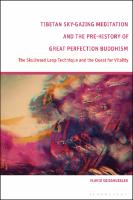Tibetan Sky-Gazing Meditation and the Pre-History of Great Perfection Buddhism
The Skullward Leap Technique and the Quest for Vitality
Abstract
Through a rigorous analysis of original scriptures and later commentaries, this open access book unearths a cornucopia of idiosyncratic motifs pervading the famous Tibetan sky-gazing meditation known as “Skullward Leap” (thod rgal). Flavio Geisshuesler argues that these motifs suggest that the practice did not originate in the context of Buddhism, but rather within indigenous Tibetan culture and in close contact with the early Bön tradition. The book argues that Dzogchen once belonged to a cult centered on the quest for vitality, which involved the worship of the sky as primordial source of life and endorsed the hunting of animals, as they were believed to be endowed with the ability to move in between the divine realm of the heavens and the world of humans. The book also traces the historical development of the Great Perfection, delineating a complex process of buddhicization that started with the introduction of Buddhism in the 7th century, intensified with the rise of new schools in the 11th century, and reached its climax in the systematization of the teachings by the great scholar-yogi Longchenpa in the 14th century. The study advances an innovative model of meditation as an open-ended practice that animates practitioners to face the most challenging moments of their lives with courage and curiosity, imagination and creativity, and playfulness and excitement; qualities that are oftentimes overlooked in contemporary descriptions of contemplation. The ebook editions of this book are available open access under a CC BY-NC-ND 4.0 licence on bloomsburycollections.com. Open access was funded by the Swiss National Science Foundation.
Keywords
rdzogs chen; thod rgal; tantra; esoteric; occultDOI
10.5040/9781350428843ISBN
9781350428829, 9781350428836, 9781350428829, 9781350428836Publisher
Bloomsbury AcademicPublisher website
https://www.bloomsbury.com/academic/Publication date and place
London, 2024Imprint
Bloomsbury AcademicClassification
Tibetan Buddhism


 Download
Download Download
Download